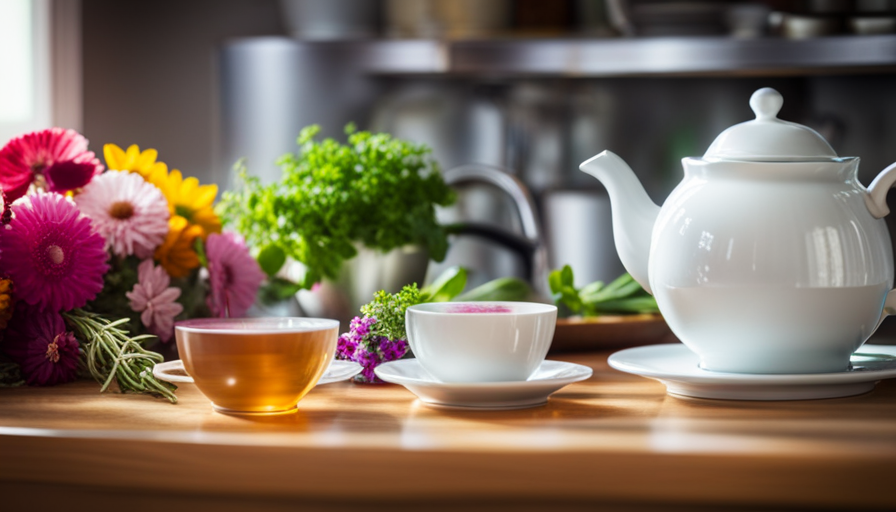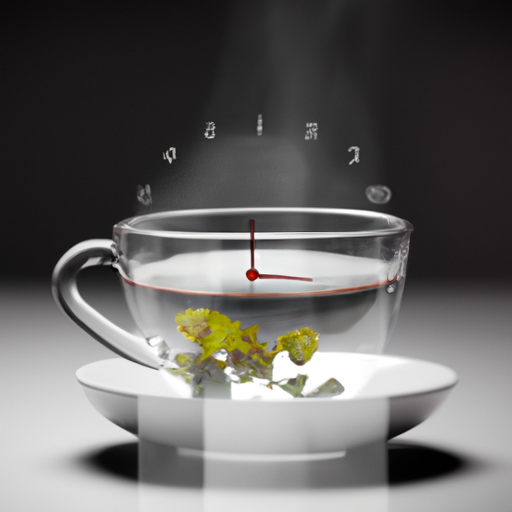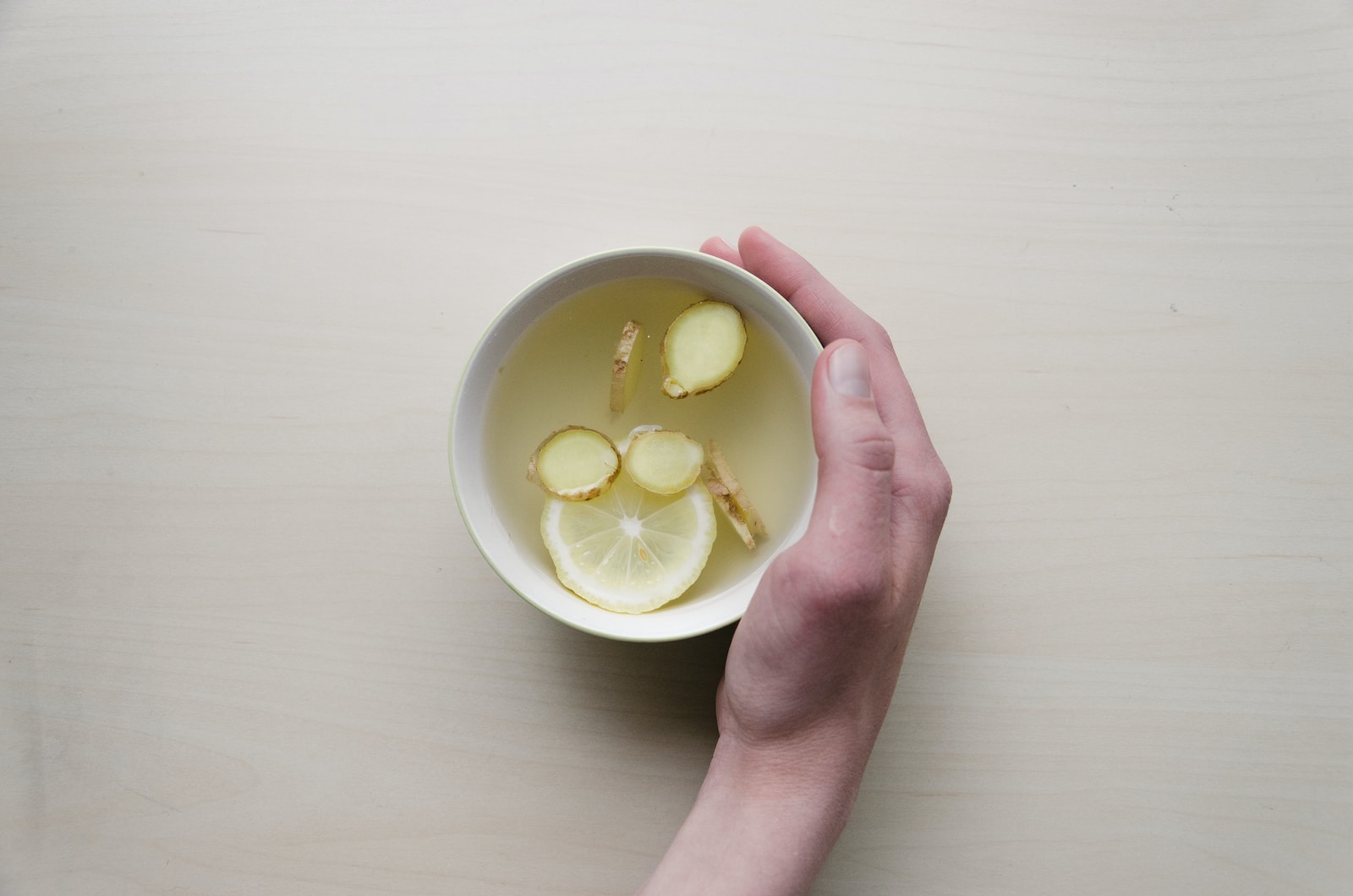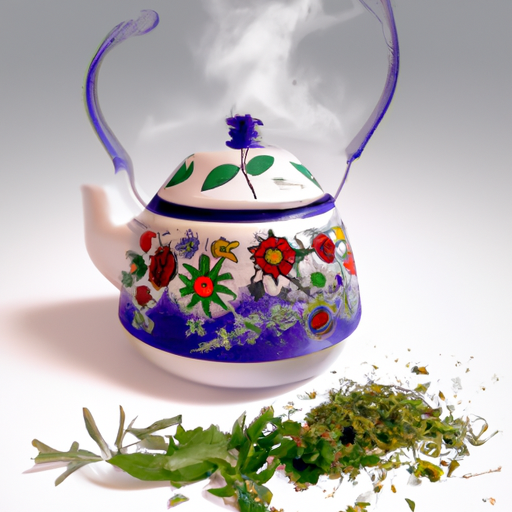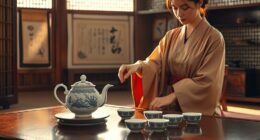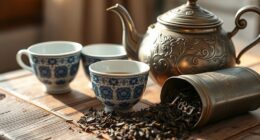Imagine returning home after a long, tiring day, yearning for a cozy and soothing drink that can relax your mind and nourish your body. That’s where herbal tea steps in.
Let me share with you my personal journey and experience of making herbal tea at home, a practice that has brought me immense joy and wellness.
One day, I stumbled upon a case study about a woman named Sarah who struggled with anxiety and insomnia. Desperate for a natural remedy, she discovered the power of herbal tea. Inspired by her story, I embarked on a mission to create my own herbal tea blends using ingredients from my garden and pantry.
In this article, I will guide you through the art of making herbal tea at home. We will explore the importance of choosing the right ingredients, gathering the necessary supplies, and preparing the perfect cup of herbal tea.
From there, I will share tips on storing and experimenting with different blends and variations. So, grab a cozy spot, and let’s dive into the world of homemade herbal tea together.
Key Takeaways
- Choosing the right ingredients is important for herbal tea.
- Experimenting with different combinations of herbs is encouraged.
- High-quality ingredients should be sourced for the best flavor and benefits.
- The general rule of thumb for measuring herbs is one teaspoon of dried herbs or one tablespoon of fresh herbs per cup of water.
Choose Your Herbal Tea Ingredients
Now it’s time to pick out your favorite herbal tea ingredients and let the aromatic journey begin! Herbal tea offers a wide range of benefits, from soothing the mind to boosting the immune system. There are countless herbal tea recipes to explore, each with its own unique flavor profile and health-promoting properties.
Whether you’re looking to relax, energize, or support your overall well-being, there’s an herbal tea blend for you. To begin, consider the benefits you’re seeking. For relaxation, chamomile and lavender are excellent choices. For a boost of energy, try green tea or peppermint. If you’re looking to support digestion, ginger or fennel can be beneficial.
Once you’ve determined your desired benefits, explore different recipes that incorporate these ingredients. Herbal tea recipes can be as simple as steeping a single herb or as complex as blending multiple herbs together. Don’t be afraid to experiment with different combinations to find your perfect brew. Remember to source high-quality ingredients for the best flavor and benefits.
Now that you’ve chosen your herbal tea ingredients, it’s time to gather your supplies and start brewing your own delicious and nourishing cup of tea.
Gather Your Supplies
First, you’ll need to grab all your gear and get ready to brew your very own cup of nature’s elixir. Before you begin, it’s important to gather the necessary supplies. You’ll need a teapot or a heatproof container, a tea infuser or a strainer, and a measuring spoon. These tools will help you make the perfect cup of herbal tea.
When it comes to measuring the ingredients for your herbal tea, it’s important to keep a few tips in mind. The general rule of thumb is to use one teaspoon of dried herbs or one tablespoon of fresh herbs per cup of water. However, this can vary depending on the type of herbal tea you’re making. Some herbs have stronger flavors and may require less, while others may need a bit more to achieve the desired taste.
There are various types of herbal tea you can choose from, each with its own unique benefits. Popular options include chamomile for relaxation, peppermint for digestion, and ginger for immunity. Experiment with different herbs to find the flavors and benefits that suit your preferences and needs.
Now that you have all your supplies and ingredients ready, it’s time to move on to preparing your water.
Prepare Your Water
To get the best flavor from your homemade herbal tea, start by ensuring your water is prepared just right. Using filtered water is important because it helps to remove impurities and chemicals that can affect the taste of your tea. Tap water often contains chlorine and other additives that can alter the delicate flavors of herbal teas. By using filtered water, you can enhance the natural taste and aroma of your tea.
Temperature also plays a crucial role in preparing herbal tea. Different herbs require different temperatures to release their flavors and medicinal properties. Generally, herbal teas are best brewed using water that’s just below boiling point, around 200°F (93°C). This allows the herbs to infuse properly and extract their beneficial compounds without being overheated.
By using filtered water and paying attention to the temperature, you can create a delicious and aromatic cup of herbal tea. Now that your water is prepared, it’s time to move on to the next step and measure your ingredients. This ensures that you have the right balance of herbs and water for the perfect cup of herbal tea.
Measure Your Ingredients
When making herbal tea at home, it’s important to measure your ingredients correctly to achieve the perfect balance of flavors. One key point to consider is the herb to water ratio, which can vary depending on the type of herb you’re using.
It’s also essential to adjust the ratio based on personal taste preferences, as some people may prefer a stronger or milder flavor. By paying attention to these factors, you can create a delicious and customized cup of herbal tea that suits your individual needs.
Herb to Water Ratio
For a stronger flavor, it’s important to use a higher herb to water ratio when making herbal tea at home. The herb infusion methods can vary, but generally, you’ll want to use about 1-2 tablespoons of dried herbs or 2-4 tablespoons of fresh herbs for every 8 ounces of water.
This ratio ensures that the herbal properties are properly extracted into the tea, resulting in a more potent and flavorful brew. Additionally, this method allows you to fully enjoy the health benefits of herbal tea, such as its antioxidant properties and potential for reducing inflammation.
Adjusting the herb to water ratio can also be a way to customize the taste of your tea. By using more or less herbs, you can create a brew that suits your personal preferences.
Moving on to adjusting for personal taste…
Adjusting for Personal Taste
Now that we’ve determined the ideal herb-to-water ratio for brewing herbal tea, let’s talk about adjusting the flavor to suit your personal taste.
The beauty of making herbal tea at home is that you have the freedom to experiment with different herbs and create a blend that delights your palate. If you prefer a stronger taste, you can increase the amount of herbs you use or steep the tea for a longer period of time.
On the other hand, if you find the flavor too overpowering, you can reduce the amount of herbs or steep the tea for a shorter duration. Remember, finding the perfect balance may require some trial and error, so don’t be afraid to get creative and take notes on your preferences.
Now, let’s move on to the next section and learn how to steep your herbal tea.
Steep Your Herbal Tea
When steeping herbal tea, it’s important to consider the recommended steeping time for optimal flavor extraction. This can vary depending on the type of herbal tea you’re using. Additionally, covering the tea during steeping helps to retain the heat and flavors of the tea, resulting in a more aromatic and flavorful brew.
If you prefer a stronger or weaker flavor, you can adjust the steeping time accordingly. Steeping for a longer period of time will result in a stronger flavor, while a shorter steeping time will produce a milder taste.
Recommended Steeping Time
Steeping herbal tea for the recommended amount of time allows the flavors to fully develop and infuse, but how long should you actually steep it? The steeping time for herbal tea can vary depending on the type of herb you are using. To help you determine the ideal steeping time, refer to the table below:
| Herb | Recommended Steeping Time |
|---|---|
| Chamomile | 5-7 minutes |
| Peppermint | 3-5 minutes |
| Lavender | 7-10 minutes |
Adjusting the steeping time for different herbs is important because it ensures that you extract the maximum flavor and benefits from each herb. For example, longer steeping times for herbs like chamomile and lavender can enhance their calming and soothing properties.
Now that you know the recommended steeping times, let’s move on to the next step: covering the tea during steeping. This helps to retain heat and prevent the essential oils and flavors from escaping.
Covering the Tea During Steeping
Covering the tea during steeping helps to lock in the aromatic essential oils and intensify the flavors, creating a truly indulgent sensory experience. By covering the tea, you create a controlled environment that allows the flavors to develop fully.
Here are some benefits of covering tea during steeping:
- Retains heat: The cover traps heat, ensuring that the water temperature remains consistent throughout the steeping process.
- Prevents evaporation: Covering the tea prevents the essential oils and flavors from evaporating, preserving the full-bodied taste.
- Enhances aroma: The cover traps the aromatic compounds, intensifying the fragrance of the tea.
- Minimizes oxidation: By covering the tea, you limit exposure to oxygen, which can lead to oxidation and a loss of flavor.
- Reduces steeping time: The cover helps to accelerate the steeping process, allowing you to enjoy your tea sooner.
Now, let’s explore how adjusting steeping time can result in a stronger or weaker flavor.
Adjusting Steeping Time for Stronger or Weaker Flavor
When it comes to making herbal tea at home, covering the tea during steeping is crucial for preserving the flavors and aromas. Now, let’s talk about adjusting the steeping time to achieve a stronger or weaker flavor. This is a simple but effective way to enhance the herbal flavors in your tea. If you prefer a stronger taste, you can extend the steeping time by a few minutes. On the other hand, if you prefer a milder flavor, you can reduce the steeping time slightly. Remember, herbal teas are quite forgiving, so feel free to experiment and find the perfect balance that suits your taste buds. Next, we will discuss how to strain and serve your freshly brewed herbal tea.
Strain and Serve
After letting the tea steep, strain it through a fine mesh sieve and serve it in your favorite mug. Straining the tea is an essential step in the process of making herbal tea. It helps remove any loose tea leaves or herbs, ensuring a smooth and enjoyable drinking experience.
There are different straining techniques you can use, but using a fine mesh sieve is one of the most effective methods. It allows the tea to pass through while catching any solids, resulting in a clear and flavorful brew.
Once you have strained the tea, it’s time to serve it. You can enjoy your herbal tea plain or add a touch of sweetness with honey or a squeeze of lemon. Serving suggestions can vary depending on your taste preferences. Some people like to garnish their tea with a sprig of fresh mint or a slice of citrus fruit. Others may prefer to drink it as is, appreciating the natural flavors of the herbs.
Now that you have learned how to strain and serve your homemade herbal tea, it’s time to sit back, relax, and enjoy your creation. The next section will explore different ways to enhance your tea-drinking experience and truly savor the flavors of your homemade herbal tea. So, let’s dive in and discover how to fully enjoy your homemade herbal tea.
Enjoy Your Homemade Herbal Tea
To fully savor the flavors of your homemade herbal tea, imagine yourself sitting back, relaxing, and enjoying every sip of your creation. Personalizing recipes is a wonderful way to make your herbal tea experience even more enjoyable. Experiment with different combinations of herbs and spices to find the perfect blend for your taste buds.
Whether you prefer a soothing chamomile and lavender blend or a refreshing mint and lemon infusion, the possibilities are endless. Not only will you be able to tailor the flavors to your liking, but you can also take advantage of the various health benefits that different herbs offer. For example, chamomile is known for its calming properties, while ginger can aid digestion. By incorporating these herbs into your tea, you can create a beverage that not only tastes great but also supports your overall well-being.
As you take your last sip, you’ll feel refreshed and revitalized, ready to face the day ahead. Now, let’s move on to the next step and learn how to store your herbal tea without compromising its flavors.
Store Your Herbal Tea
Now that you’ve enjoyed your homemade herbal tea, it’s important to know how to properly store it to maintain its freshness and flavor. By using the right storing techniques, you can extend the shelf life of your herbal tea and ensure that each cup you brew is as delightful as the first.
To begin, it’s crucial to store your herbal tea in an airtight container. This’ll prevent moisture and air from seeping in, which can lead to the loss of aroma and taste. Ideal containers for this purpose are glass jars with tight-fitting lids or resealable bags.
Additionally, keep your herbal tea away from direct sunlight, heat, and humidity. These factors can accelerate the deterioration of the tea leaves and diminish their quality. Instead, store your tea in a cool and dark place, such as a pantry or cupboard.
To evoke a sense of comfort and satisfaction in your tea-drinking experience, create a nested bullet point list in markdown format with the following sub-lists:
-
Organize your tea collection:
- Arrange your herbal tea varieties neatly, allowing easy access and a visually pleasing display.
- Categorize them by flavor profiles, such as floral, citrusy, or earthy.
- Label each container with the name and brewing instructions for convenience.
-
Rotate your tea:
- To ensure that your herbal tea remains fresh, rotate your collection regularly.
- Use the ‘first in, first out’ principle to prioritize older teas before newer ones.
By following these storing techniques, you can extend the shelf life of your herbal tea and maintain its delightful taste. Now, let’s move on to the next section and experiment with blends and variations to further elevate our tea experience.
Experiment with Blends and Variations
When it comes to experimenting with blends and variations in herbal tea, I love mixing different herbs and spices to create unique flavors and health benefits. It’s fascinating to discover how different combinations can enhance the taste and aroma of the tea.
Additionally, trying different tea base options, such as green tea, white tea, or even floral teas, adds another layer of complexity to the blend, making it a truly enjoyable and versatile experience.
Mixing Different Herbs and Spices
Ah, nothing beats the magical alchemy of mixing various herbs and spices to create the perfect cup of herbal tea. When it comes to herbal tea, mixing different herbs and spices not only enhances the flavor but also offers a range of health benefits. By blending different herbs and spices, you can create unique flavor combinations that tantalize your taste buds and provide a holistic experience. For example, combining chamomile and lavender promotes relaxation, while adding ginger and lemon zest offers a refreshing and invigorating taste. To help you explore these options, here is a table showcasing some popular herb and spice combinations:
| Herb/Spice Combination | Flavor Profile |
|---|---|
| Chamomile + Lavender | Relaxing |
| Ginger + Lemon Zest | Invigorating |
| Peppermint + Spearmint | Cooling |
| Cinnamon + Cardamom | Warming |
Mixing different herbs and spices allows you to personalize your herbal tea experience and discover unique flavors that suit your preferences. Now, let’s delve into trying different tea base options.
Trying Different Tea Base Options
Experimenting with various tea bases opens up a world of possibilities, allowing me to embark on a journey of unique and delightful flavors. By combining different herbs and spices with different tea bases, I can create flavorful tea combinations that cater to my personal preferences.
For example, using a green tea base can provide a refreshing and slightly grassy taste, while a black tea base adds richness and depth to the blend. Additionally, herbal teas have various health benefits depending on the ingredients used. Chamomile tea, for instance, is known for its calming properties, while peppermint tea can aid digestion.
With all these options available, I can create a wide range of herbal teas that not only taste great but also offer different health benefits.
Now, let’s move on to the next section and share your homemade herbal tea creations.
Share Your Homemade Herbal Tea
To enhance the flavor profile of your homemade herbal tea, you can easily infuse it with fresh ingredients like mint leaves or slices of citrus fruits. Not only will this add a burst of flavor, but it can also provide additional health benefits. Here are a few ways you can share your homemade herbal tea:
-
Share your favorite herbal tea recipe: Whether it’s a calming chamomile blend or an energizing ginger and turmeric concoction, sharing your recipe can inspire others to try new flavors and create their own unique blends. Don’t forget to include the ingredients and brewing instructions!
-
Discuss the health benefits of herbal tea: Herbal teas are known for their various health benefits. For example, chamomile tea has calming properties that can help with sleep, while ginger tea can aid digestion and reduce inflammation. By sharing the health benefits of your herbal tea, you can encourage others to incorporate it into their daily routine.
-
Invite others to join a tea tasting session: Organize a tea tasting session where you can share your homemade herbal tea with friends and family. This is a great way to bond over a cup of tea and exchange ideas for new flavors and combinations.
-
Create a tea swap group: If you have a circle of tea enthusiasts, consider starting a tea swap group. Each member can bring their homemade herbal tea and exchange it with others, allowing everyone to try different flavors and expand their tea collection.
By sharing your homemade herbal tea, you not only spread the joy of tea but also inspire others to explore the world of herbal infusions and enjoy the many health benefits they offer. So, grab your teapot and get ready to share your delicious creations!
Frequently Asked Questions
Can I use fresh herbs instead of dried herbs to make herbal tea?
Yes, you can definitely use fresh herbs instead of dried herbs to make herbal tea. Using fresh herbs in herbal tea has several benefits. Fresh herbs are known to have a higher concentration of essential oils, antioxidants, and other beneficial compounds compared to dried herbs. This can enhance the flavor, aroma, and overall health benefits of the tea. Additionally, fresh herbs can provide a more vibrant and refreshing taste to your herbal tea.
How long does it take for herbal tea to steep?
To enhance the flavor of herbal tea and fully enjoy its benefits for relaxation, it’s important to steep it for the right amount of time. The steeping time varies depending on the type of herbs used. Generally, herbal tea should be steeped for about 5-7 minutes to ensure that the flavors and medicinal properties are fully extracted.
Steeping for too long can result in a bitter taste, while steeping for too short can result in a weak flavor.
Can I sweeten my herbal tea with honey or sugar?
Yes, you can sweeten your herbal tea with alternative sweeteners like honey or sugar. However, I recommend using natural sweeteners like honey or stevia for added health benefits. For example, a case study found that honey has antioxidant and antimicrobial properties, which can support the immune system and soothe a sore throat. Additionally, using honey as a natural sweetener can provide a subtle and unique flavor to your herbal tea.
Other alternatives include stevia or maple syrup, which can enhance the taste without adding unnecessary calories or artificial ingredients.
Can I reuse the herbs for a second steeping?
Yes, you can definitely reuse the herbs for a second steeping. In fact, there are several benefits to doing so. Reusing herbs allows you to extract more flavor and nutrients from them, resulting in a stronger and more beneficial tea.
Additionally, it can help to reduce waste and make your herbs last longer. Just make sure to adjust the steeping time and temperature accordingly to avoid over-extracting the flavors.
Can I mix different types of herbal tea together to create my own blend?
Mixing herbal teas allows for the creation of unique and creative blends, much like combining different colors to paint a masterpiece. By experimenting with flavors, you can discover delightful combinations that suit your taste buds.
Whether it’s a soothing blend of chamomile and lavender or a refreshing mix of peppermint and lemon balm, the possibilities are endless. Just remember to start with small quantities and adjust the ratios based on your preferences. Let your imagination guide you on this flavorful journey.
Conclusion
In conclusion, making herbal tea at home is a simple and rewarding experience. By choosing your own ingredients and following a few easy steps, you can create a personalized blend that suits your taste and health needs.
Not only does homemade herbal tea offer numerous health benefits, but it also allows for creativity and experimentation in the kitchen. So why not give it a try? You might just discover your new favorite beverage and share it with friends and family.
Cheers to good health and delicious homemade tea!

